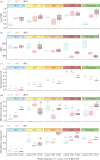The microbiome at the interface between environmental stress and animal health: an example from the most threatened vertebrate group
- PMID: 39291456
- PMCID: PMC11409201
- DOI: 10.1098/rspb.2024.0917
The microbiome at the interface between environmental stress and animal health: an example from the most threatened vertebrate group
Abstract
Nitrate pollution and global warming are ubiquitous stressors likely to interact and affect the health and survival of wildlife, particularly aquatic ectotherms. Animal health is largely influenced by its microbiome (commensal/symbiotic microorganisms), which responds to such stressors. We used a crossed experimental design including three nitrate levels and five temperature regimes to investigate their interactive and individual effects on an aquatic ectotherm, the European common frog. We associated health biomarkers in larvae with changes in gut bacteria diversity and composition. Larvae experienced higher stress levels and lower body condition under high temperatures and nitrate exposure. Developmental rate increased with temperature but decreased with nitrate pollution. Alterations in bacteria composition but not diversity are likely to correlate with the observed outcomes in larvae health. Leucine degradation decreased at higher temperatures corroborating accelerated development, nitrate degradation increased with nitrate level corroborating reduced body condition and an increase in lysine biosynthesis may have helped larvae deal with the combined effects of both stressors. These results reinforce the importance of associating traditional health biomarkers with underlying microbiome changes. Therefore, we urge studies to investigate the effects of environmental stressors on microbiome composition and consequences for host health in a world threatened by biodiversity loss.
Keywords: Rana temporaria; global warming; gut microbiome; multiple stressors; nitrate pollution; water-borne corticosterone.
Conflict of interest statement
The authors declare that the research was conducted in the absence of any commercial or financial relationships that could be construed as a potential conflict of interest.
Figures


References
-
- Mann ME, Bradley RS, Hughes MK. 1998. Global-scale temperature patterns and climate forcing over the past six centuries. Nature 392 , 779–787. ( 10.1038/33859) - DOI
-
- Ruddiman WF. 2013. The Anthropocene. Annu. Rev. Earth Planet. Sci. 41 , 45–68. ( 10.1146/annurev-earth-050212-123944) - DOI
-
- McCallum ML. 2015. Vertebrate biodiversity losses point to a sixth mass extinction. Biodivers. Conserv. 24 , 2497–2519. ( 10.1007/s10531-015-0940-6) - DOI
MeSH terms
Substances
Grants and funding
LinkOut - more resources
Full Text Sources
Medical

